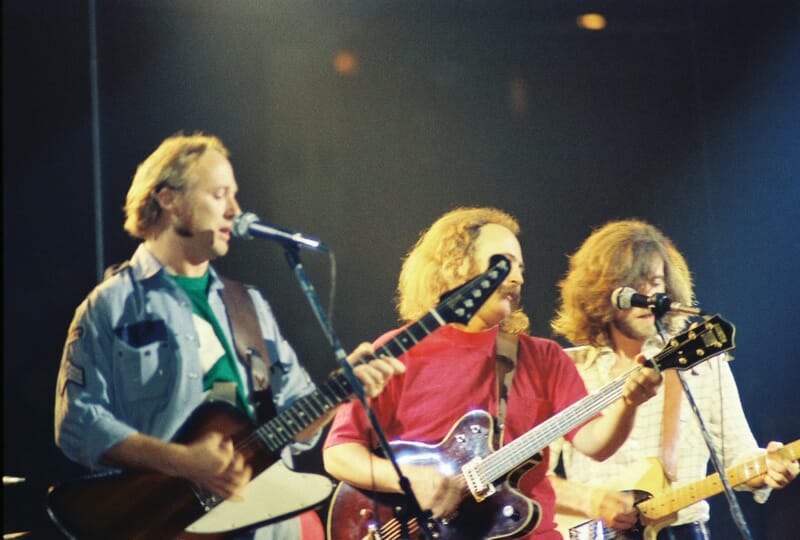
Crosby, Stills & Nash | A matter of balance
Artist
Year
Country
Tracks
Runtime
Written by
Produced by
Label
On a warm July evening of 1968, English musician Graham Nash travelled from London to Los Angeles to visit Joni Mitchell for a few days. He could not wait to see her. But as he approached her Laurel Canyon house he noticed there were other people inside and felt hesitant, as he recounted in an interview years later. For a long moment, he considered going away. When he finally went in, he found two old friends, Stephen Stills and David Crosby, sitting on Joni’s sofa. No one could suspect it, but had Nash walked away, a founding stone of Rock History might never have happened.
At some point in the evening, Stills picked up his guitar and, with Crosby singing along, he performed one of his compositions: You Don’t Have to Cry. “Would you do that again?” said Nash; “Once again” he repeated. After three repetitions he joined them, and magic finally happened. “Whatever vocal sound that Crosby, Stills and Nash has was born in less than 40 seconds” he declared in that same interview. About a year later, in May 1969, they released their first album, Crosby, Stills & Nash. A delicate blend of folk, blues and jazz, the album helped initiate a sea change in popular music, making it a cornerstone in rock history.
The Magic Canyon
There was something special about the Laurel Canyon scene. Between the mid-60s and the early-70s, some of the subtler American popular music was written there. It was home to Joni Mitchell, Neil Young, The Mamas and the Papas, and this is just the beginning. According to music journalist Lisa Robinson, “the scene was more metaphorical than geographical. Nearly everyone who was there was, at one time or another, stoned; nobody remembers everything the same way.” It should not come as a surprise, then, that Stills’ memory of that very first performance is different: CS&N first sang together in Cass Elliot’s house, he told Robinson.
Whatever the truth is, what matters is that they were deeply immersed in the scene when they made their debut as a trio. The sound of the Canyon was somewhat revolutionary: a blend of influences that ranged from blues and folk to Latin and psychedelia. The same taste for a crossover of genres is palpable in CS&N’s debut. Was this not enough, all of them just came out from successful music experiences. Stills played with Buffalo Springfield, Crosby with The Byrds, and Nash with The Hollies. They were experienced musicians moving in one of the most stimulating scenes around. The album could only be a success.
Behind the sound
Crosby, Stills & Nash was a brilliant debut for the trio. They were lifted to stardom in the blink of an eye. In November ’69, the album was n° 7 on Billboard’s Top Album Chart, and it stayed on the chart for 19 weeks. It was clear: there was natural chemistry between Crosby, Stills & Nash, and it was not just about their voices. The creative and personal difference between the three could not be greater, and each one of them had his peculiar strength. Yet, it seemed easy to balance them.
With his diverse musical skills and his original composing styles, Stills dominated the recording of the album. “Suite: Judy Blue eyes” perfectly displays his composing style: a four-part acoustic track, the song meshes the form of a classical music suite with traditional pop insights and CS&N’s signature three-part harmonies. After his experience with The Hollies, Nash was trained to write good pop songs. As he would declare years later, “I took that sensibility and talked about what I consider to be deeper, more profound subjects”. Thanks to this skill, he wrote one of the most successful tracks of the album: “Marrakesh Express”. On his side, Crosby had a talent for social commentary lyrics. That is the case for “Long Time Gone”, which he wrote the night of Bobby Kennedy’s murder. With its funky bass and rock organ, it is one of the grooviest tracks of the album.
Apart from the fruitful contaminations with other genres, the album features some beautiful pure folk songs. With its picked acoustic guitar backing and the trademark three-part vocals, “Helplessly Hoping” is the ultimate CS&N song.
The road to success
After the release of the album, Crosby, Stills & Nash suddenly gained their place in the pantheon of rock. The unique taste for contamination, the surprising hit-making ability, the unmistakable blend of their voices, made their debut album a pivot in rock history. That same summer, the band played in some high profile festival like Woodstock and Big Sur. Meanwhile, the arrival of a fourth element turned the trio into a quartet, and the man was none other than Neil Young.
Two years later, Crosby, Stills, Nash & Young published their first album as a quartet, Déjà Vu. It was the beginning of a long collaboration which would result in six albums and numerous tours. One of the most talented musicians and songwriters in the Canyon, Young was a great addition to the band. Unfortunately, over the years his relations with Crosby grew so tense that in 2016 he swore they would never work together again. Yet, the success of their collaboration remains undeniable. Speaking to Lisa Robinson about the CSN&Y years, Crosby declared that “there was a point where I think we were the best band in the world.”
A matter of balance
Fifty years after that very first performance at Joni Mitchell’s place, the influence of Crosby, Stills & Nash could not be greater. The album ranks at number 262 in Rolling Stones’ list of the 500 greatest albums of all times. It has had a massive impact on the Laurel Canyon scene, and set a virtuous example for the development of the California sound in the 70s, influencing artists like Jackson Browne, the Eagles and Fleetwood Mac. Yet, its impact stretched to modern times and reached bands like Mumford & Sons, Wilco, and Haim.
With this in mind, one could wonder: what would have happened had Nash walked away from Joni Mitchell’s house? One thing is for certain: sometimes the best things are born out of the subtlest balances.
You can stream Crosby Stills & Nash on Spotify.
Tag
Buy a ☕ for Hypercritic










